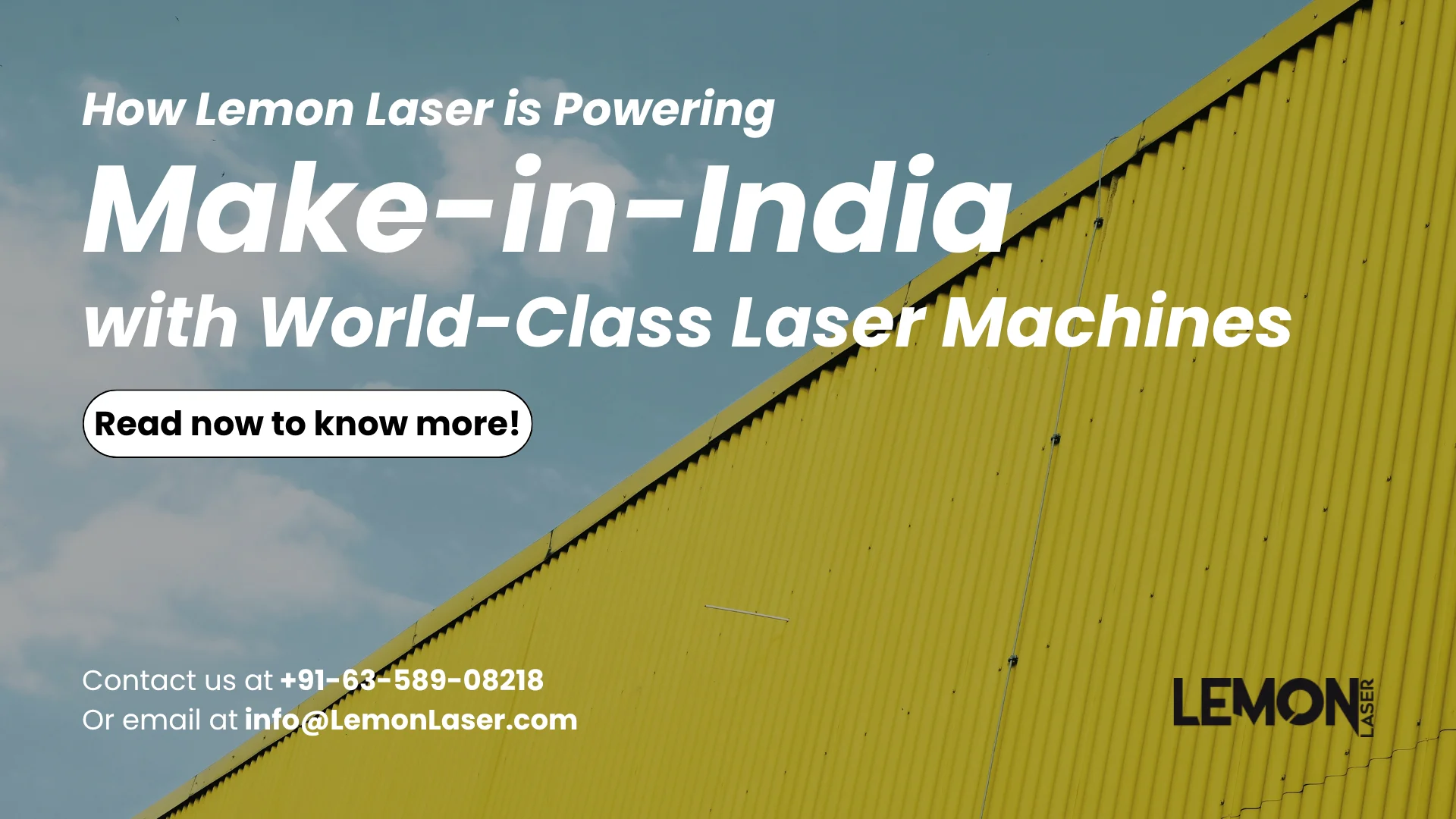Currently Empty: ₹0.00
Laser cutting technology has transformed how the world designs, manufactures, and creates. From industrial-scale fabrication to delicate artistic detailing, the same fundamental technology – a focused beam of light – is being used to shape everything from thick metal plates to intricate jewelry. At Lemon Lasers, we’ve seen how this technology bridges the gap between heavy industry and fine artistry.
In this blog, we’ll explore how modern laser cutting has evolved, the science behind it, and how it has become a cornerstone of both industrial engineering and creative craftsmanship. We’ll also look at how Lemon Lasers’ machines empower Indian manufacturers, artisans, and designers to innovate across industries – truly embodying the spirit of Make-in-India precision.
The Evolution of Laser Cutting: From Labs to Workshops
The story of laser cutting began in the 1960s when lasers were first used to drill holes in diamond dies. Over the decades, advancements in fiber laser sources, CNC automation, and optics have made the technology faster, more precise, and more energy-efficient.
Today, laser cutting is no longer confined to research labs or high-end aerospace facilities – it’s in fabrication shops, jewelry studios, signage units, and even home décor startups.
Modern laser systems, like those engineered by Lemon Lasers, combine power, accuracy, and flexibility, allowing users to cut metals, plastics, wood, ceramics, fabrics, and precious materials – all with the same machine platform and unparalleled control.
How Laser Cutting Works?
At its core, laser cutting uses a concentrated beam of light to melt, burn, or vaporize material along a programmed path. Here’s a quick breakdown of the process:
Beam Generation:
A laser source (typically fiber, CO₂, or diode) emits a high-energy light beam.
Focusing:
This beam is focused through lenses or mirrors onto the material surface, achieving an energy density so high that it melts or vaporizes the target instantly.
Cutting Motion:
CNC (Computer Numerical Control) systems move the laser head or workpiece precisely to follow intricate designs or industrial blueprints.
Assist Gases:
Gases like nitrogen or oxygen are used to blow away molten material and improve edge quality.
This precision-focused process allows for clean, burr-free cuts and complex geometries that are impossible to achieve with traditional mechanical tools.
Why Laser Cutting Has Become the Universal Manufacturing Tool?
Laser cutting has emerged as a go-to process across diverse sectors because it brings together precision, speed, and versatility – three qualities that modern production demands.
- Extreme Precision: With tolerance levels as fine as ±0.01 mm, laser cutting delivers exactness unmatched by plasma or waterjet cutting. This makes it ideal for both industrial-grade sheet metal and delicate jewelry patterns.
- Speed and Efficiency: High-speed cutting heads and optimized nesting software drastically reduce cycle times. Lemon Lasers’ fiber cutters can slice through stainless steel or aluminum several times faster than mechanical methods.
- No Tool Wear: Since there’s no physical contact between tool and material, there’s no blade wear or deformation, keeping quality consistent over thousands of cuts.
- Clean Finishes, No Post-Processing: The smooth edges produced by laser cutting often eliminate the need for polishing or finishing, saving time and cost.
- Minimal Material Waste: Laser cutting is incredibly precise – the narrow kerf width (cut line) ensures maximum material utilization, which is crucial when working with expensive metals like gold, silver, or titanium.
The Industrial Side: Sheet Metal Cutting
In heavy industries and fabrication units, sheet metal cutting is one of the most common and vital applications of laser technology.
Applications:
- Automotive and EV Manufacturing: Cutting car body panels, battery trays, and precision brackets.
- Aerospace: Lightweight components with zero defects.
- Electronics: Cutting thin steel enclosures and intricate ventilation slots.
- Construction and Furniture: Structural panels, signage, and decorative screens.
- Advantages for Industry:
- Faster throughput for mass production.
- Consistent quality across long production runs.
- Ability to cut thick sheets (up to 100 mm with Lemon Lasers’ ultra-high-power systems).
- Integration with CNC automation and robotics for smart manufacturing.
Laser cutting helps manufacturers move from conventional fabrication to precision engineering, improving both productivity and profitability.
The Artistic Side: Fine Jewelry and Design
What’s fascinating about modern laser cutting is its duality – the same technology that cuts heavy steel plates can also carve delicate filigree patterns on gold, silver, or platinum.
In the jewelry and design sector, laser cutting has opened endless creative possibilities:
1. Intricate Detailing: Designers can cut ultra-fine lace-like patterns that were once only possible through handwork – now achieved with absolute repeatability.
2. Non-Contact Cutting: The non-contact nature prevents material distortion, making it perfect for thin sheets of precious metals.
3. Precision Engraving and Customization: Laser systems can switch seamlessly from cutting to engraving, allowing for engraved names, serial numbers, and logos – ideal for personalized jewelry.
4. Zero Wastage of Precious Material: Every gram counts in jewelry manufacturing. With a kerf width as narrow as 0.1 mm, laser cutting minimizes gold and silver loss.
5. Design Freedom: Complex CAD designs can be imported directly into the machine, enabling intricate geometries, micro patterns, and creative textures that traditional methods can’t achieve.
For jewelers, laser technology merges craftsmanship with computer precision – preserving artistry while scaling production efficiently.
Lemon Lasers: Bridging Heavy Industry and Fine Art
Lemon Lasers is at the forefront of laser innovation in India, offering machines that serve the full spectrum – from robust industrial cutters to precision micro-cutting systems.
1. High-Power Fiber Laser Systems for Industry: Lemon’s fiber laser cutting machines, ranging from 1 kW to 20 kW, are built for high-speed cutting of metals like MS, SS, aluminum, brass, and copper.
- Advanced CNC motion control ensures micron-level accuracy.
- Adaptive optics handle reflective materials without loss of beam quality.
- Automatic nozzle cleaning and focus adjustment improve uptime.
2. Compact Precision Lasers for Creative Industries: For jewelry, décor, and micro-fabrication, Lemon Lasers offers low-power, ultra-precise systems that deliver detailed designs on thin metals and non-metals.
- Ideal for fine cutting, engraving, and patterning.
- Software integration for intricate design execution.
- Compact footprint for workshops and studios.
3. Smart Automation & IoT Integration: All Lemon Lasers machines are Industry 4.0 ready, supporting automation, production tracking, and cloud-based monitoring.
4. Local Manufacturing, Global Standards: Every Lemon Lasers machine is designed and built in India, ensuring affordability, easy maintenance, and availability of spares – while matching international quality and reliability.
Environmental and Economic Advantages
Laser cutting aligns perfectly with modern manufacturing goals of sustainability and cost-effectiveness:
- Energy Efficient: Fiber lasers convert over 40% of input power into laser energy, far more efficient than CO₂ systems.
- Reduced Scrap: Precision cutting minimizes material wastage, saving resources and money.
- Cleaner Process: No mechanical contact or lubricants means less pollution and fewer consumables.
- Low Maintenance: With fewer moving parts and no tool wear, maintenance costs remain minimal.
For both industrial manufacturers and artisans, laser cutting is an investment in efficiency, quality, and environmental responsibility.
Case Example: One Technology, Multiple Success Stories
- Automotive Fabricator in Pune:
A local supplier replaced its plasma cutting line with Lemon’s 6 kW fiber laser cutter – reducing cutting time by 60% and improving part quality to meet export standards. - Jewelry Studio in Surat:
An artisan jeweler adopted Lemon’s precision laser cutting and engraving system to produce intricate bridal designs. The result? Faster turnaround, minimal gold wastage, and consistent detail unmatched by handcrafting alone. - Architectural Design Firm in Delhi:
Using Lemon’s mid-power laser cutter, a décor firm created complex metal partitions and facade panels, merging strength and artistry for luxury interiors.
These examples illustrate the universal adaptability of laser technology – empowering both industrial scale and creative expression.
The Future: Smarter, Finer, Greener
As technology evolves, the future of laser cutting is even more exciting. Upcoming trends include:
- AI-powered cutting optimization: Real-time adjustments for speed and quality.
- Ultrafast lasers: Capable of cutting micro-features without any heat damage.
- Hybrid machines: Combining laser cutting, marking, and engraving in one system.
- Digital twin integration: Simulating cuts before production to save material and time.
Lemon Lasers is continuously investing in R&D and innovation, ensuring Indian manufacturers remain globally competitive while embracing the next wave of smart manufacturing.
Conclusion: Precision That Cuts Across Industries
From heavy-duty sheet metal fabrication to the fine curves of handcrafted jewelry, modern laser cutting represents the perfect blend of strength and sophistication. It has replaced age-old mechanical methods with a process that’s cleaner, faster, more accurate, and infinitely more creative.
By delivering high-performance, Make-in-India laser cutting machines, Lemon Lasers is empowering industries of all scales – from factories that build vehicles to studios that craft art.
No matter the material, scale, or application, laser precision is redefining possibilities – cutting through challenges, shaping the future, and proving that innovation has no boundaries.




